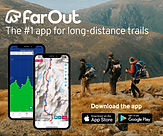
Resource Center
Top 10 essentials for a thru-hike.
10 Essentials for a Thru-Hike
1. SHELTER – Tent, space blanket, tarp, and bivy.
Shelter is one of the most important elements during a thru-hike. It can protect you from severe weather conditions and exposure to the elements. A tent, tarp, bivy sack, or emergency space blanket are all light weight options for hiking and shelter.
2. HYDRATION – Water and water treatment supplies.
Staying hydrated on your trip is of utmost importance! Physical activity increases your risk of dehydration (loss of water and salts from the body), which can lead to negative health consequences. If you’re active outdoors (hiking, biking, running, swimming, etc.), especially in hot weather, you should drink water often and before you feel thirsty. Prepare your water before you need it and do not allow yourself to become dehydrated. Before heading out on your trip, be sure to identify if there are any bodies of water at your destination that you could collect water from and treat using your water treatment supplies.
3. NUTRITION - Food
You should always be prepared for the possibility of changes to your trip plans. Pack an extra day's supply of food, preferably no-cook items that have good nutritional value in order to keep your energy high. Salty and easy to digest snacks (e.g. trail mix, nuts, and granola bars) work well for outdoor activities.
4. ILLUMINATION – Flashlight, lanterns, and headlamp
Lighting is indispensable in the outdoors where no conventional light sources can be found. Items include flashlights, lanterns, and headlamps. Headlamps are the preferred light source because they are hands-free. Be sure to pack extra batteries.
5. FIRST-AID SUPPLIES – First Aid Kit
Be prepared for emergencies by packing first-aid supplies with you. Start with a pre-made kit and modify it to fit your trip and your medical needs. Check the expiration date on all items and replace them as needed. Consider including an emergency guide in case you are faced with an unfamiliar medical emergency.
6. INSULATION – Jacket, hat, gloves, rain shell, and thermal underwear
Nature is unpredictable. Be prepared for sudden changes in weather conditions. Pack an extra layer of clothing that reflects the most extreme conditions you could encounter.
7. SUN PROTECTION – Sunglasses, sunscreen, and hat
Sun protection is necessary to protect your skin and eyes against harsh UV rays that are responsible for sunburns and skin cancer. Consider using sunglasses, sunscreen, and hats. Sun-protection clothing such as pants and long sleeve shirts can also help minimize your exposure to the sun.
8. FIRE – Matches, lighter and fire starters
Fire can be an emergency signal and a heat source for cooking and staying warm. Pack matches (preferably waterproof) and fire starters - items that catch fire quickly and sustain a flame (e.g. lighter). Familiarize yourself with the fire use regulations of your park before heading out.
9. NAVIGATION – Map, compass, and GPS system
Navigation systems are used when planning your route before your trip, and when you need help orienting yourself in your surroundings during your activity. Know how to use a topographical or relief map as well as your compass or GPS unit before going out.
10. REPAIR KIT AND TOOLS – Duct tape, knife, screwdriver, and scissors
Carry a basic repair kit with you to help repair equipment. The kit should include items such as duct tape, a knife, and scissors. Consider packing a multi-tool, a compact version of many tools that can include a knife, screwdriver, can opener, etc. Be sure to bring any tools specific to your trip and your activity.
Trail Info and References...Top 10 hiking trails.
1. The Appalachian Trail-
http://www.appalachiantrail.org/
2. Pacific Crest Trail-
3. Continental Divide Trail-
www.continentaldividetrail.org
4. The Arizona Trail-
5. Colorado Trail-
6. Florida National Scenic Trail-
7. John Muir Trail-
www.pcta.org/discover-the-trail/john-muir-trail/
8. Ice Age Trail-
9. Cirque of the Towers Trail-
www.alltrails.com/trail/us/wyoming/cirque-of-the-towers-trail
10. American Discovery Trail-

Top 10 Hiking Apps.
1. FarOut
2. Peak Visor
3. Cairn
4. Mountain Collector
5. Maps 3D Pro
6. Map My Hike GPS
7. Spyglass
8. AllTrails
9. Viewranger
10. Gaia GPS
How to Deal With Your Fear of Snakes
They’re slithery, occasionally venomous, and many hikers’ worst nightmare. Learning to coexist with these reptiles just takes a little knowledge. Click link to read this informative article by Back Packer Mag.
www.backpackermagazine.com
TOP 5 MOST COMMON THRU-HIKER MISTAKES
-
Too Big of a Pack
-
Poor Gear Choices
-
Food/Mail drop Planning (too much/too little, selection, lack of nutrition)
-
The Lack of Physical Conditioning
-
Poor Planning in General (timing, too much/too little planning)




%201.png)
